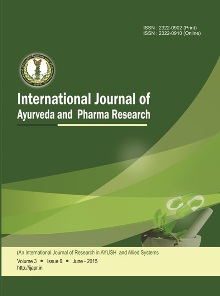PRAGMATIC USAGE OF HARITAKI (TERMINALIA CHEBULA RETZ): AN AYURVEDIC PERSPECTIVE VIS-A-VIS CURRENT PRACTICE
Abstract
Haritaki (Chebulic myrobalan-Terminalia chebula Retz (Combretaceae Family) denotes a fruit having dark greenish yellow colour, which drives away diseases. The widely acclaimed Ayurvedic drug is the best wholesome substance and safe for bodily passages (haritaki pathyanam). Haritaki enjoys wide patronage in Tibetan medicine also which is known as A-ru-ra and praised with the adjective Sman-mchog-rgyal-pa (the king of best medicines). Haritaki in day to day life by judicious combinations of different adjuvants will be a boon for the person who consumes it. Though the Ayurvedic texts provide decent options such as Rituharitaki (Seasonal use of Haritaki with selective adjuvant), specific indications and contra indications, may practitioners as well as others do not pay much attention to them. This has lead to the underutilization of this wonderful fruit drug. It is the time to take fresh look at the Ayurvedic perspective of pragmatic usage of Haritaki in the light of current therapeutic evidence, pharmaceutical practices.






